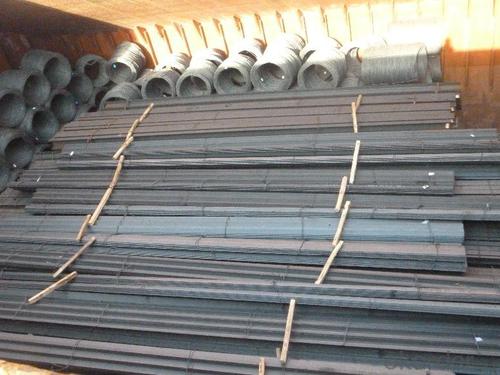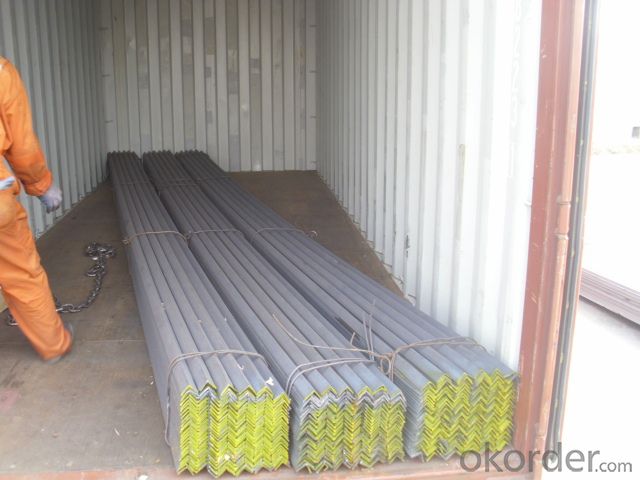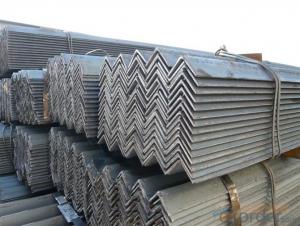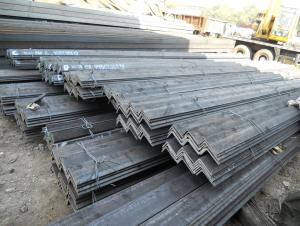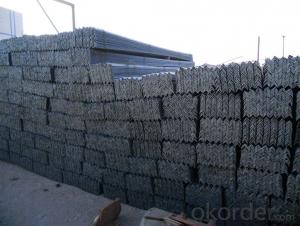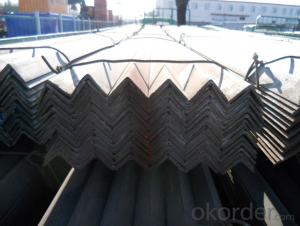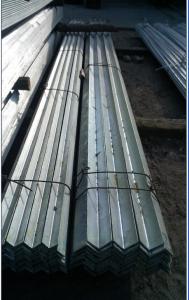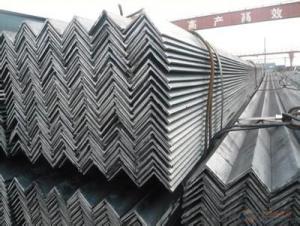GB Q235 Steel Angle with High Quality 40*40mm
- Loading Port:
- Tianjin
- Payment Terms:
- TT or LC
- Min Order Qty:
- 25 m.t
- Supply Capability:
- 10000 m.t/month
OKorder Service Pledge
OKorder Financial Service
You Might Also Like
Specifications of GB Q235 Steel Angle with High Quality 40*40mm:
1.Standards:GB
2.Length:6m, 12m
3.Material:Q235 or Equivalent
4.Size:
Size (mm) | Mass (kg/m) | Size (mm) | Mass (kg/m) |
| 40*40*3 | 1.852 | 40*40*5 | 2.976 |
| 40*40*4 | 2.422 |
Usage & Applications of GB Q235 Steel Angle with High Quality 40*40mm:
Trusses;
Transmission towers;
Telecommunication towers;
Bracing for general structures;
Stiffeners in structural use.
Packaging & Delivery of GB Q235 Steel Angle with High Quality 40*40mm:
1. Transportation: the goods are delivered by truck from mill to loading port, the maximum quantity can be loaded is around 40MTs by each truck. If the order quantity cannot reach the full truck loaded, the transportation cost per ton will be little higher than full load.
2. With bundles and load in 20 feet/40 feet container, or by bulk cargo, also we could do as customers' request.
3. Marks:
Color mark: There will be color marking on both end of the bundle for the cargo delivered by bulk vessel. That makes it easily to distinguish at the destination port.
Tag mark: There will be tag mark tied up on the bundles. The information usually including supplier logo and name, product name, made in China, shipping marks and other information request by the customer.
If loading by container the marking is not needed, but we will prepare it as customers' request.
FAQ:
Q1: Why buy Materials & Equipment from OKorder.com?
A1: All products offered byOKorder.com are carefully selected from China's most reliable manufacturing enterprises. Through its ISO certifications, OKorder.com adheres to the highest standards and a commitment to supply chain safety and customer satisfaction.
Q2: How do we guarantee the quality of our products?
A2: We have established an advanced quality management system which conducts strict quality tests at every step, from raw materials to the final product. At the same time, we provide extensive follow-up service assurances as required.
Q3: How soon can we receive the product after purchase?
A3: Within three days of placing an order, we will arrange production. The shipping date is dependent upon the quatity, how many sizes you want and the plan of production, but is typically 30 to 45 days from the beginning of production.
Images of GB Q235 Steel Angle with High Quality 40*40mm:

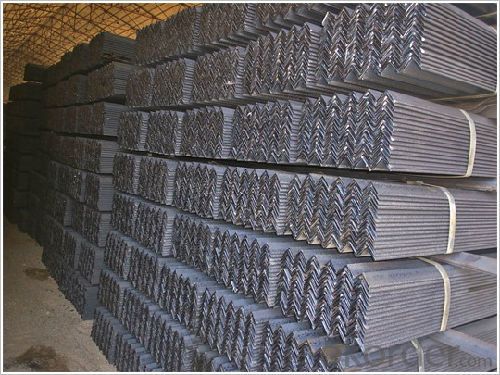
*If you would like to get our price, please inform us the size, standard/material and quantity. Thank you very much for your attention.
- Q: How do you prevent buckling of steel angles under compressive loads?
- To prevent buckling of steel angles under compressive loads, several measures can be taken. Firstly, increasing the thickness of the angle can enhance its resistance to buckling. Additionally, reinforcing the angle with stiffeners or gussets can provide added stability. Proper bracing and support during installation can also help prevent buckling. Finally, considering the design and load distribution in the structure can aid in preventing excessive compressive forces on the steel angles.
- Q: Are steel angles available in different grades?
- Different grades of steel angles are indeed available. Carbon steel is the commonly used material for steel angles, and it comes in various grades like A36, A572, and A588. These grades possess distinct chemical compositions and mechanical properties, rendering them suitable for diverse applications. Furthermore, stainless steel angles are also obtainable in grades such as 304 and 316, which exhibit exceptional corrosion resistance characteristics. Selecting the appropriate grade of steel angle depends on specific project requirements, encompassing strength, longevity, and resistance to corrosion.
- Q: What are the different methods of fire protection for steel angles?
- There are several different methods of fire protection for steel angles, depending on the specific requirements and regulations. Some common methods include: 1. Passive Fire Protection: This involves applying fire-resistant materials directly to the steel angles. These materials can include fire-resistant coatings, fireproofing sprays, or intumescent paints. These coatings can help delay the spread of fire and provide insulation, protecting the steel angles from the high temperatures produced during a fire. 2. Encasement: Another method is to encase the steel angles in fire-resistant materials such as concrete or gypsum board. This creates a barrier between the steel and the fire, preventing it from reaching critical temperatures that could cause structural failure. 3. Fireproofing Systems: Fireproofing systems involve the use of fire-resistant boards or panels that are attached to the steel angles. These systems provide a layer of insulation and protection against fire, preventing the steel from heating up quickly and maintaining its structural integrity for a longer period. 4. Sprinkler Systems: Installing sprinkler systems can also help protect steel angles from fire. These systems are designed to detect and suppress fires by releasing water or fire-suppressing agents when triggered. By quickly extinguishing the fire, the sprinklers can prevent the steel angles from reaching critical temperatures. 5. Fire-resistant barriers: Fire-resistant barriers, such as fire-resistant walls or curtains, can be utilized to separate steel angles from potential fire sources. These barriers can help contain the fire and prevent it from spreading to the steel angles, providing an additional layer of protection. It is important to consult with fire protection experts, engineers, and local building codes to determine the most suitable method of fire protection for steel angles in a specific setting. The choice of method may depend on factors such as the type of building, fire safety requirements, and the level of fire risk involved.
- Q: How do you maintain and clean steel angles?
- To maintain and clean steel angles, you can start by removing any dirt or debris using a mild soap and water solution. Avoid using abrasive cleaners or tools that can scratch the surface of the steel. After cleaning, it is important to thoroughly dry the angles to prevent any water spots or rust formation. Applying a protective coating or wax can also help maintain their appearance and prevent corrosion. Regular inspections and prompt removal of any rust spots or stains will ensure the longevity of the steel angles.
- Q: Can steel angles be used for supporting mechanical equipment?
- Yes, steel angles can be used for supporting mechanical equipment. Steel angles are commonly used in construction and engineering projects for their strength, durability, and versatility. They provide a stable and rigid support structure for various types of mechanical equipment, including heavy machinery, conveyors, and support frames. Steel angles are known for their load-bearing capacity, which makes them ideal for providing structural support in industrial applications. Additionally, their L-shaped design allows for easy installation and attachment of equipment. Overall, steel angles are a reliable and commonly used choice for supporting mechanical equipment due to their strength, durability, and ease of use.
- Q: What are the maximum allowable deflections for steel angles?
- Various factors, such as the type of angle used, material properties, loading conditions, and adherence to design codes and standards, influence the maximum allowable deflections for steel angles. To ensure the structural integrity and functionality of steel angles, deflection limits are established. Excessive deflections can lead to structural instability, reduced load-carrying capacity, and potential failure of the angles. Deflection criteria for different applications are specified by design codes and standards like the American Institute of Steel Construction (AISC). For instance, the AISC 360-16 specification sets deflection limits based on the span length and serviceability requirements of the specific structure. Allowable deflections for steel angles are typically expressed as a fraction of the unsupported span length. Depending on the particular application and loading conditions, typical deflection limits range from 1/240 to 1/360 of the span length. It is important to consider that these deflection limits serve as guidelines and must be evaluated alongside other design considerations such as strength, stability, and dynamic effects. To determine the precise maximum allowable deflections for steel angles in a given project, consulting the relevant design codes and standards and seeking professional engineering advice is crucial.
- Q: Can steel angles be used for column supports?
- Yes, steel angles can be used for column supports. Steel angles are commonly used in construction as they provide structural support and stability, making them suitable for column supports. They offer excellent strength and load-bearing capacity, making them a reliable choice for supporting vertical loads.
- Q: Are steel angles resistant to UV radiation?
- Steel angles do not naturally possess resistance to UV radiation. However, the degree of resistance can vary based on the type of steel utilized and the application of a protective coating on the surface. When left unprotected, steel angles like hot-rolled or cold-formed steel can undergo deterioration and corrosion when exposed to UV radiation for extended periods. The ultraviolet rays have the ability to induce oxidation in the steel, resulting in the formation of rust and weakening the structure. To counteract the impact of UV radiation, protective finishes such as galvanized zinc, paint, or powder coating can be applied to steel angles. These coatings act as a barrier between the steel and the surroundings, offering protection against UV radiation and preventing oxidation and corrosion. It is important to acknowledge that despite the presence of protective coatings, prolonged exposure to intense UV radiation can still cause some deterioration over time. Therefore, regular inspection and maintenance are crucial in ensuring the durability and structural integrity of steel angles utilized in outdoor or UV-exposed applications.
- Q: What is the typical thickness tolerance for steel angles?
- The thickness tolerance for steel angles may vary based on manufacturing standards and requirements. Typically, steel angles have a thickness tolerance ranging from +/- 0.005 to 0.010 inches (0.13 to 0.25 mm). Nevertheless, it is crucial to consider that the tolerance can be affected by the size and dimensions of the angle. Larger and thicker steel angles may have slightly more lenient tolerances compared to smaller and thinner angles. To determine the precise thickness tolerance for a specific steel angle, it is advisable to refer to the appropriate industry standards or specifications.
- Q: Are steel angles corrosion-resistant?
- Yes, steel angles are corrosion-resistant due to the protective oxide layer that forms on their surface, which helps prevent rusting and degradation.
Send your message to us
GB Q235 Steel Angle with High Quality 40*40mm
- Loading Port:
- Tianjin
- Payment Terms:
- TT or LC
- Min Order Qty:
- 25 m.t
- Supply Capability:
- 10000 m.t/month
OKorder Service Pledge
OKorder Financial Service
Similar products
Hot products
Hot Searches
Related keywords



